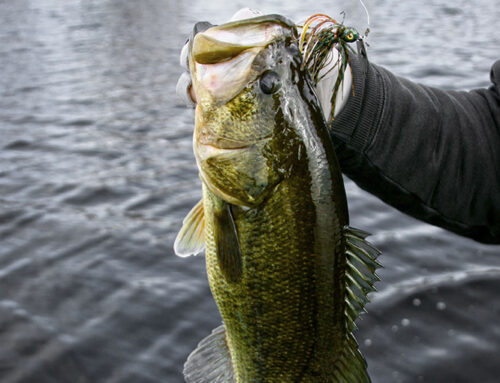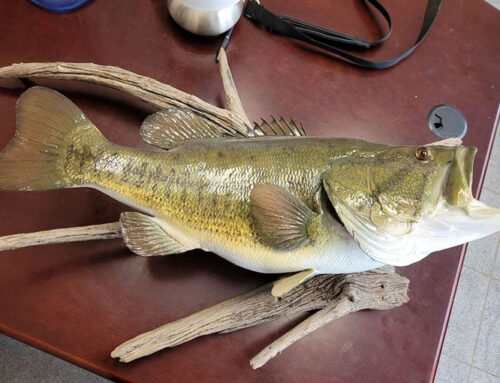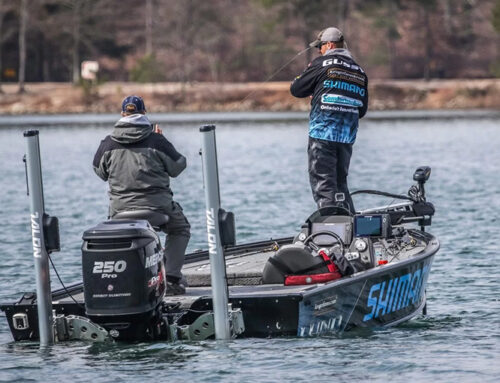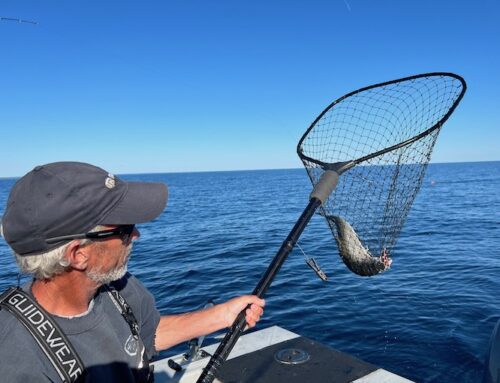
The shallowest of the Great Lakes, Erie is also the most productive. When there’s a good walleye hatch, the western and central basins are some of the top producers in Canada.
Although sometimes overshadowed by other areas of the lake, Erie’s eastern basin is no slouch. It’s home to a trophy smallmouth bass population, decent perch numbers, walleye, and lake trout. Stories of smallmouths “as large as footballs” are what first drew me to explore the eastern basin beyond my home waters of Long Point Bay.
Technically speaking, the eastern basin is delineated by the Pennsylvania Ridge, which runs from the western base of Long Point to Presque Isle, Pennsylvania. It’s the deepest part of the lake, with an average depth of 82 feet, and contains “The Hole,” which reaches 210 feet in depth.
This article concentrates on the waters from Turkey Point east to the Niagara River. The Canadian side of Erie in this stretch is irregular, with many reefs dominating the near-shore topography. More than one propeller or, worse yet, entire bottom end has met its demise at the quick changes of depth associated with these reefs. While tough on fishing boats, they do create fish habitat.
Bronze bruisers
I wasn’t disappointed when fishing with Simon Frost of St. Catharine’s, near the Niagara River. Frost has a reputation of winning tournaments on Lake Erie and knowing it like the back of his hand.
OOD Associate Editor Ray Blades and I met Frost last September to fish near Fort Erie. Frost believes the east end of the lake holds more bass and the average size is larger. His personal best is a whopping 7.29 pounds, and he often sees 5- to 6-pounders.
We started fishing close to the U.S./Canada border in about 40 feet of water. Since fishing with two rods is legal there, Frost was using one rigged for tube jigs and one for drop-shotting, which accounted for more fish. Some of them hit hard, but most lightly, almost like a touch. Frost says, if you feel a bite, slightly lift the rod tip, then, if there’s pressure, set the hook. If a fish is on, don’t drop your rod tip.
Bass that morning averaged two to three pounds. Frost told us typically there’s a time during the morning when the action switches to larger fish. Although we picked up a few around four pounds, there was nothing into five or six pounds, so we moved, first trying a reef right at the river and then moving into shallower flats off Crystal Beach. Ray had some luck with a spinnerbait. Frost also likes spinnerbaits when fish are roaming. I had what was likely the largest fish of the day up to the boat, before it snapped the line. Later, we moved back to the mouth of the Niagara river and I redeemed myself, catching a 4 1⁄2-pounder.
All told, we fished seven hours and caught more than 60 smallmouths. The largest was 4 1⁄2 pounds and many more were in the 3 1⁄2- to 4-pound range. Throughout the day, Frost was open about sharing the secrets of his success. For Erie smallmouths, he prefers a rod with a sensitive tip and lots of backbone. A reel with a smooth drag, spooled with 6-pound fluorocarbon line, rounds out the setup. He has his own line of terminal tackle.
With so much water that it can be daunting, one of Frost’s tips for locating fish is to find the transition from sand to rock bottom. “And subtle breaks,” he added. “I find the big fish on them, not the 5- to 10-foot breaks.”
First up
Early in the season, Frost starts looking for smallmouths near spawning grounds. Mid-summer presents a challenge, as bass roam, chasing bait. Frost has success on offshore shoals then. By fall, the fish are moving to wintering grounds, often in 30 to 40 feet of water. Tubes are Frost’s bait of choice when bass are feeding on crayfish and gobies.
“A lot of the time, I let the graph tell me what to do,” he said. “If the fish are 3 feet off bottom, I set it (the bait) at 3 feet. If they’re on bottom, most often I use a tube.” He believes in letting the bait provide a subtle action.
He changes bait colour throughout the season, matching the smallmouth food source. When they’re feeding on baitfish, he prefers smoke with silver fleck or smoke with purple fleck. When the bass switch to feeding on gobies and crayfish on bottom, he uses green pumpkin and dark melon. One key with both drop-shotting and tube jigs is having sharp hooks. “The bites are light; you have to get it into them quickly,” he said.
A new meaning to black bass
My first taste of fishing east-end bass was last August 2011. Initially, my intention was to fish yellow perch in the Dunnville area, but I had my trolling rods along just in case. There was a minnow shortage in the area, which often happens in summer. With no minnows, friend Chris Rell and I did a target change, launching from Mike Walker’s Mohawk Marina after hearing tales of the smallmouth and walleye action.
We were one of only two boats trolling off Mohawk Island and its historic lighthouse for walleye. None were willing to connect, but I did catch a smallmouth in the three to four-pound range on lead-core line. I was amazed at the darkness of the fish. It was almost black. Frost later told me smallmouth living in rocky areas are darker.
With a little more time, I’m sure we could have put a few more notches in the rod from catching smallmouths. “This place is full of bass,” Walker said. “We had a lot of weed growth and it’s good for smallmouths.” The bass move, dependent on water temperature and time of year, but are generally in 15 to 30 feet of water. Walker said 6-pounders are not uncommon.
More bass
The waters off Normandale and Port Ryerse are often a first stop when large numbers of smallmouths that spawn in Inner Long Point Bay head for deeper water. There are also resident bass along the shoreline between Turkey Point and Nanticoke.
Daryl Wells of Wells Bait and Tackle, near Port Dover, says some of the prime spots for bass through summer are Port Ryerse, Wooley’s Point, and Nanticoke. Wells says anglers favour leeches, twister-tail plastics, and spinnerbaits for catching bass.
Darren Jacko, a tournament angler and guide, also fishes both sides of Erie’s east end for smallmouths. His most important piece of advice is to fish contours. “If you’ve never fished there before, hop on a contour and fish at the 14-foot mark, 18-foot mark, 21-foot mark, and 27-foot mark, and you should be able to figure out where the fish are.”
Full-time guide Paul Castellano of CAST Adventures has great success with swimbaits. He doesn’t have one colour that outproduces, saying what works in shallow water might not work deeper, and vice versa. “I really believe even if a bait is working, it’s great to try another colour,” he said.
He also advises to look for subtle differences in the bottom or isolated boulders to find fish.
Tasty perch
In a typical year, most of the large yellow perch leave Long Point Bay after spawning to head for cooler waters.
Normandale, just east of Turkey Point, is one of the staging areas in spring and in September when the fish migrate back into the bay. I’ve often caught perch there in the past.
“This end of the lake seems to be doing well and seems to be stable,” Kurt Oldenburg, Lake Erie Ministry of Natural Resources fisheries ecology supervisor, said of perch numbers. Besides Friday 13th and motorbikes, Port Dover’s other claim to fame is its restaurants that serve Lake Erie perch.
Spring kicks off with Port Dover’s annual perch derby, held from late April to early May. Although a boat gives you more versatility, people line the pier to catch fish. Wells says most anglers fishing for early season perch are within a mile of shore near Port Dover, fishing in about six to seven feet of water. Others head for Normandale.
“Pickerel rigs are the biggest things, but it depends if they get soft mouthed,” he said of the popular perch tactics. “If they do, use a No. 6 hook. Some guys use a float.”
Waters off Dunnville, Port Colborne, and Fort Erie all offer excellent opportunities for jumbo perch. I had my first taste of perching farther east with Steve Hardcastle of Fishmaster Ultimate Charters last fall. Lucas Dracz of Dunnville joined us for the day. Our destination was deeper water more than seven miles out of Normandale, just east of Turkey Point, is one of the staging areas in spring and in September when the fish migrate back into the bay. I’ve often caught perch there in the past.
“This end of the lake seems to be doing well and seems to be stable,” Kurt Oldenburg, Lake Erie Ministry of Natural Resources fisheries ecology supervisor, said of perch numbers.
Besides Friday 13th and motorbikes, Port Dover’s other claim to fame is its restaurants that serve Lake Erie perch. Spring kicks off with Port Dover’s annual perch derby, held from late April to early May. Although a boat gives you more versatility, people line the pier to catch fish. Wells says most anglers fishing for early season perch are within a mile of shore near Port Dover, fishing in about six to seven feet of water. Others head for Normandale.
“Pickerel rigs are the biggest things, but it depends if they get soft mouthed,” he said of the popular perch tactics. “If they do, use a No. 6 hook. Some guys use a float.”
Waters off Dunnville, Port Colborne, and Fort Erie all offer excellent opportunities for jumbo perch. I had my first taste of perching farther east with Steve Hardcastle of Fishmaster Ultimate Charters last fall. Lucas Dracz of Dunnville joined us for the day. Our destination was deeper water more than seven miles out of Port Maitland, past Mohawk Island. While on route, Hardcastle explained the perch are closer to shore earlier in the season and caught from the Port Maitland pier in June and July. “That pier is lined from one end to the other (with anglers),” he said.
As the water warms, the fish head for depths in the 80- to 100-foot range in July and August, and then gradually shallower in fall as the water cools. We fished in 60 feet of water. I quickly found the fish were big. The first one was more than 10 inches. Over the next 31⁄2 hours, we boated 86 perch, with the largest at 133⁄4 inches.
During that time, Hardcastle talked to a friend fishing off Port Colborne, who said there were 125 boat trailers in the parking lot there. “The fishing is just as good here and no crowd,” said Hardcastle. In fact, we only saw one or two boats, and those were distant dots on the horizon.
We were using pickerel rigs with 1- to 11⁄2-ounce sinkers to keep our minnows close to bottom. Although I was using monofilament, Hardcastle prefers lowstretch line for fishing deep. The secret is to allow the line to sink to bottom on a little slack. “Then, slowly lift,” Hardcastle said. “If you feel sudden weight, set the hook.”
Off another lighthouse
I also sampled perch fishing this April with Denis Kreze of Fishin’ Niagara in Fort Erie. After meeting at the boat ramp in Crystal Beach, we headed west of Point Abino. This was my first up-close look at this the area’s lighthouse.
Kreze is a tournament fisherman. He’d been out the day before to find the fish, so we headed west out of Crystal Beach. We searched near his GPS waypoint until the sonar screen was filled with fish and bait. To start, we both used identical rods, reels, and rigs Kreze provided.
He prefers a 5- to 6-foot rod with a sensitive tip and uses a setup similar to a Carolina rig to catch light biters. His braided line connects to 20 feet of fluorocarbon with a tiny swivel and a No. 6 octopus hook on the end. He rigs with an egg sinker so the fish can grab the bait without feeling the weight, as is the case with traditional sinkers. “The only thing they feel is the rod tip, and then it’s too late because you hook them,” he said.
The morning started out with my catch rate similar to Kreze’s. Then, I tried an experiment, dropping a pickerel rig with two hooks that was on my rod. “You won’t catch many with that,” Kreze warned. He was right, as he pulled in three perch before I felt one bite, but it was an interesting experiment. I switched to a Carolina rig. Although my catch rate increased, the braid still gave Kreze an edge.
He hooks minnows through the dorsal fin, saying they stay more lively than when hooked through the mouth. “You will always know if the minnow is there,” he added.
He also moves to stay on top of the perch, instead of waiting for them to swim back under the boat.
We ended up keeping 50 perch for about three hours of fishing, but we threw back nearly as many females and smaller ones. We’d made a decision to only keep male perch and to release the females to spawn, as they were still full of eggs.
Generally, he finds the perch fishing stays good into June, when the fish go deeper.
Walleye ways
Eastern-basin walleye are less numerous than in the west, but the locals believe they’re larger. Some are the area’s shoal spawners, others spawn in the Grand River, and more migrate from the western basin.
Kreze finds walleye on the Canadian side of the lake near Fort Erie after they’ve spawned. “Wherever you see birds diving after bait, fish there,” he said. Typically, a sonar will show the bait, but often not the walleye.
Kreze trolls slowly, usually at 15 feet down, with stickbaits. His favourite colours are clown, perch, and silver and black. He uses planer boards and makes lots of turns. As the season progresses and fish go deeper, he switches to Hot and Tots and worm harnesses.
He also fishes off Mohawk Island with warm harnesses, planer boards, and divers for suspended walleye.
Walker sees 12-pound walleye, but he says most anglers want 3- to 4-pounders, which are better table fare.
In a typical year, walleye fishing runs from mid-July through Labour Day. Walker advises anglers to look for rock bottom. “They don’t like mud,” he said.
Dracz runs 7 to 10 miles southwest from Port Maitland when searching for walleye. He usually starts in 50 to 60 feet of water and trolls deeper as the season progresses. Worm harnesses are his favourites, presented on divers. He usually trolls 1.5 to 1.7 miles per hour early in the season and speeds up to 1.7 to 2.2 later on.
Other fish, too
An angler pursuing lake trout or steelhead in the eastern basin is more rare than the fish. Oldenburg says rainbow trout stockings on both sides of the lake are at good levels, but anglers aren’t pursuing them.
“There’s some sort of issue with shifting of habitat,” he said. “We’re not quite sure what that is.”
One hypothesis is there’s a shifting of nutrients by zebra mussels. As a result, eastern-basin steelhead might not be where anglers are used to looking for them. There was once a devoted crowd after steelhead near the Long Point lighthouse and the waters in between the tip and Nanticoke.
Wells says one hot spot for rainbows is the mouth of Young’s Creek early in the season when the fish are returning to the lake from spawning.
Both Ontario and the U.S. also stock good numbers of lake trout, but Oldenburg says not many anglers target them, either.
Is a record lurking?
No doubt Erie’s east end has great fishing, and especially incredible smallmouths. With one of Castellano’s clients catching a 24 1⁄4-incher in the nearby Niagara River, could the next Ontario record be swimming in eastern Lake Erie? That fish exceeded the record in length, but was lean by a pound at 8 pounds. It’s easy to believe that in all that water there’s a larger bass out there.

Originally published in the July 2012 issue of Ontario OUT of DOORS magazine.
Jeff Helsdon lives in the turkey-rich woods of southwestern Ontario. He enjoys hunting upland game with his English cocker spaniel, hunting deer and waterfowl, and fishing with his wife and family. Reach Jeff at: mail@niteowldev.com






I caught a smally in Lake Huron fishing from a kayak last summer. Once to shore I weighed it and it turned out to be less than a pound away from the largest smallmouth catch ever recorded in Ontario. It was weak from the fight so I wanted to release it ASAP but didn’t have a tape measure handy so don’t know the length but it was 1 & 1/2 feet at least and a girth like none I’d seen before.